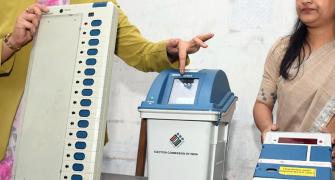When Rakesh Prabhu, a 38-year-old public sector executive, landed at Aurangabad, once the southern capital of the last great Mughal emperor Aurangzeb, after being transferred from Mumbai a year ago, he was a much depressed man.
What was worrying him was not children's school admission (the schools here are as good) or wife's job (she's anyway a housewife). He was not going to miss Juhu beach (the hills here are as beautiful) or weekend trips to Elephanta caves (Ellora caves are just 35 km from Aurangabad).
The real life was okay, it was his reel affair that was giving him jitters. Here's the confession: Prabhu is a die-hard movie buff who has been for years watching most Bollywood films in the first weekend, if not on the opening day, of their release. And, since the advent of multiplexes in Mumbai, he had been enjoying the show even more, sometimes watching two or even three movies on a single day.
Now, in Aurangabad, most movies would be releasing a week or two later than in Mumbai. Worse, the nightmarish ghost theatres of yesteryears -- with their creaky fans, stinking loos, ragged seats with bugs and long-torn cushions and noisy projectors -- would return to disturb Prabhu's Bollywood dreams. . . he, of course, had a reason to be worried.
Now, cut to present. Here's Prabhu, across the street in Aurangabad's Jalna Road, waving at you with a huge grin on his face. He's not flashing a transfer order; that's a cinema ticket in his hand. He's about to watch Apna Sapna Money Money on the day of the movie's national release. And he's doing it in the cosy atmosphere of the brand new PVR multiplex that's come up in the town.
India's multiplex bandwagon has gone beyond the metros to redefine entertainment in B and C class towns. "While the first phase (of the multiplex story) saw emergence of multiplexes in metros and now this growth is spreading to Tier 2 and 3 cities like Lucknow, Indore, Nasik, Aurangabad, Kanpur, Amritsar and so on," says Ajay Bijli, managing director, PVR Cinemas. And PVR is not alone.
Other top multiplex players like Adlabs Films (where Anil Ambani holds a 51% stake), Inox Leisures, Shringar Cinemas (Fame multiplexes), Fun Multiplex (of Essel group) and Cinemax India too have ventured to small towns across the country from Darjeeling to Mangalore to Ghaziabad to Pimpri to Pune to Panipat to Allahabad to Indore to Latur to Agra to Thane to Lucknow to Hyderabad to Nasik to Jaipur to Visakhapatnam.
Projects are under way in places like Kochi, Bhatinda, Coimbatore, Kota, Madurai and Ambala. "Metro or non metro, if a town has a population of more than 10 lakh (1 million) people, we are interested," says Alok Tandon, chief operating officer, Inox.
"About 38 cities in India would qualify for that," he adds. "Given that there is little or no means of entertainment in B and C class towns, there is a huge potential for multiplexes," says Devang Sampat, general manager, marketing, Cinemax.
The rising prominence of smaller towns can be gauged from the fact that movie stars are now touching down at these places to promote their films. If Aamir Khan was in Thane, a suburb of Mumbai, for the release of Rang de Basanti, more recently Amrita Rao was in Nasik for the release of Vivaah.
"After two years, non metros will clearly be the drivers for film exhibition companies," says a foreign fund manager, who owns and tracks multiplex stocks. "With box office collections from non metros, expected to move up one cannot ignore the smaller towns."
At present, as much as 65% of the total box office collections in the country come from non metros, says Sampat of Cinemax. "We see this changing to 30:70 metro-non metro in three-to-five years," he adds.
Look at their plans. PVR, which raised almost Rs 128 crore (Rs 1.28 billion) last December through its initial public offering, has gone for a new brand, PVR Talkies, to foray into smaller places.
PVR Talkies plans to enter 70 cities -- including Khanna, Jalandhar, Amritsar and Moradabad -- over the next three-to-five years. Adlabs, which says it would invest
Rs 200 crore (Rs 2 billion) over the next three years, is eyeing places like Hyderabad, Delhi and NCR, Agra, Jalandhar, Ludhiana, Indore and Allahabad.
Inox, which has entered into a share swap deal to take over Calcutta Cene Pvt Ltd (CCPL) -- known for its multiplex brand 89 Cinema -- already has multiplexes in smaller places like Vadodara, Darjeeling, Goa, Indore, Jaipur, Kota, Nagpur and Pune.
Its theatres are coming up at Chennai, Hyderabad, Jodhpur, Raipur, Lucknow, Nagpur, Kharagpur, Borivali, Pune and Vijayawada. Further, the CCPL merger will bring in nine multiplexes in West Bengal and Assam to its fold. Similarly, Shringar -- already operating in Kandivali, Surat, Nasik and Pimpri -- is taking its Fame to places like Aurangabad and Thane.
Pricing It Right
As in metros, in smaller towns too it is the retail boom that's mostly driving the multiplex story. Mall developers all over the country are wooing multiplexes to occupy their top floors as anchor tenants who would ensure footfalls.
"The arrival of the mall syndrome has accelerated the growth of cineplexes as multiplexes are the anchor tenants in most of these malls," says Shravan Shroff, managing director, Shringar Cinemas.
But the game is slightly different here from that in metros. For one, multiplexes are forced to price their tickets lower as affordability levels are lower in smaller cities.
"Customers in these towns would not have the capacity to pay upwards of Rs 100 for a ticket, hence we have entered these towns under a separate brand name of PVR Talkies," says Ashish Shukla, chief executive officer, PVR Talkies.
Cinemax, for example, has priced its tickets at less than Rs 100 in Nashik, while in its Mumbai property the average ticket price is Rs 150. Also, revenues from food and beverages (F&B) and advertisements are lower in smaller towns.
According to Sampat of Cinemax, F&B revenue constitute 15-20% in non-metros compared to 20-25% in metros. "While ad revenue in metros would be 10%, non metros would yield 5%," he adds. "Since my margins in food and beverages are as high as 65%, lower F&B revenues from the segment, would delay my break even in B and C class cities," murmurs a multiplex operator who doesn't want to be named.
Industry watchers feel this will change. "Over time, F&B and ad revenues from non metros would match the metros," says Chintan Mewar, analyst at Almondz Securities. Also, the consumer preferences are different. If hotdogs and popcorn are popular in the metros and semi-metros, in smaller towns, people would rather go for the traditional samosas and vada paavs.
To make up for lower revenues, exhibitors are entering the B and C towns without some of the frills they offer in metros. For example, while Cinemax offers reclining chairs in Versova, Mumbai the chairs are simpler in Nashik. PVR has an air-cooled lobby in Latur, while the lobbies in its metro properties are air-conditioned. But they won't call it cost cutting. "The ambience is adjusted to the local environment," as per PVR's Shukla.
Farewell, Single Screen
So what if multiplexes constitute just 1% of the total number of cinema halls, and 4-5% of the 12,900 screens, in India, the industry is talking about the end of single screens. Single screens, with their low quality ambience, would find it tough to survive in the long run, it is felt.
"Over a period of time, theatres will die a natural death," says Sampat. This because there is a rising demand for quality cinema exhibition infrastructure. Also, before long, digitisation will be the industry standard and exhibitors will have to shift to it.
"Though the propensity to watch movies in India is high, there is a big gap in terms of quality-viewing experience between the metros and the smaller cities," says Tushar Dhingra, chief operating officer, Adlabs.
In India, there are only 12 screens per million population compared to 117 screens per million in the US and more than 40 screens per million for European countries.
Now, what are the risks involved? Increasing property prices is a big concern, of course. But most multiplex owners have tied up properties for at least the next couple of years. Also, being the anchor tenants in a mall, they are always offered special rates by developers.
"Since we have signed up properties for the next two-to-three years, and get preferred rates as we are anchor tenant, we are not worried about the rise in property prices," says Tandon of Inox. It's the same for other top players as well. "One of our key focus areas is also expansion to smaller towns, with populations of up to five lakh (500,000). Property prices in these places have been comparatively stable, which makes us bullish on our plans for these cities," says Bijli of PVR.
So, at least on the surface, there's nothing much to stop the multiplex boom.
The coming of age of direct-to-home services like movie-on-demand and live gaming are unlikely to make the millions of Prabhus across a country of fanatic fans (have you heard of the temple named after South Indian actress Khushboo or about the guy who offered his pocket knife to an unarmed Amitabh Bachchan surrounded by villains and tore apart the screen in the process?) resist the first day-first show temptation of Bollywood.







